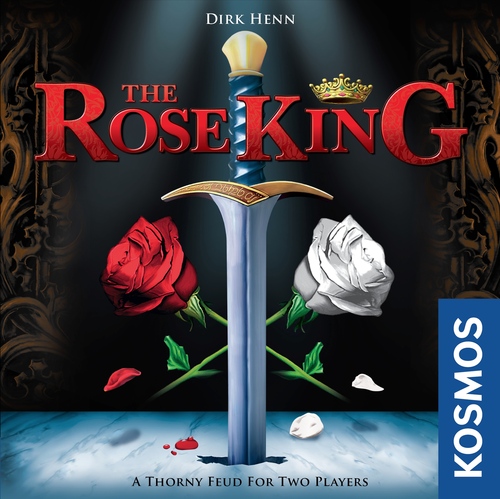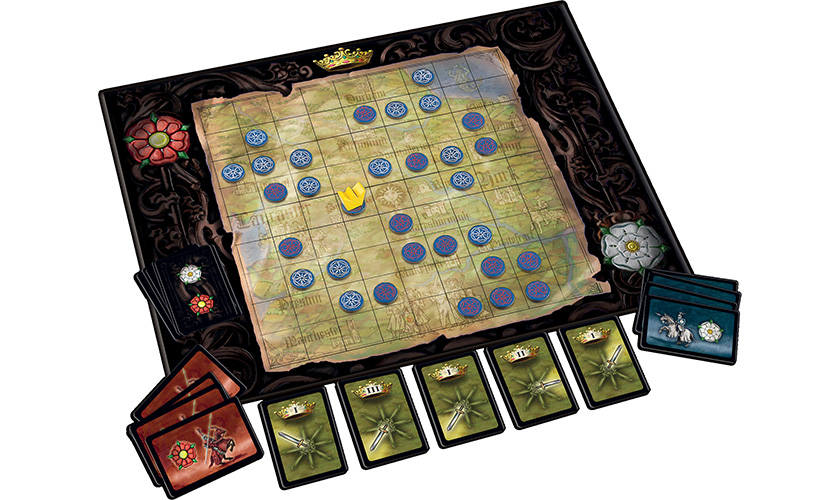When it comes to history outside of the US, I’m absolutely clueless. When I hear “War of the Roses”, for example, I just picture two English dudes with monocles and cups of tea slapping each other in the face with a bouquet of roses. Now that I’ve lost half of my European audience, lets move on to why we’re really here: “The Rose King”, a two player game that focuses on area control. Special thanks to Eve Vergnes from Southard Communications, Inc. for providing me with a press copy for review purposes.

The Rose King: 2 Players, Ages 10+, Average Play Time = 30 Minutes
Components
The game includes 1 Game Board, 52 Power Tokens (red on one side, white on the other), 24 Power Cards (one card containing a I, II, or III and a direction), 8 Hero Cards (4 white, 4 red), a crown token, and a rulebook.
Setup & Gameplay
The board is placed between players so that the side with the crown is facing the player controlling red. The power cards are shuffled and each player gets five face-up with the rest forming a face-down draw pile. It’s important that the players orient these cards so that the crown on the board has the same orientation as the one on the cards. Each player also gets four hero cards of their matching color. The crown token starts in the center space with red going first.
On a player’s turn they can do one of three things:
1. Play a power card – The player will discard a power card and move the crown token a number of spaces (indicated by the roman numeral) in a particular direction (indicated by the sword). A player can only move to an empty space and cannot either move off the board or shorten their move. Once on the empty space, the player places a power token of their color on that space.
2. Draw a power card – The player can draw a power card from the draw pile, though only if they have less than five cards. The discard pile is shuffled to be the new draw pile should the draw pile run out.
3. Play a hero card along with a power card – The hero card allows the player to land on an opponent’s space (normally not allowed) and flip it to their color. Both the hero card and power card are discarded.
Players continue taking turns until they cannot carry out any more moves or if a player places their last power token on the board. Players then calculate their scores by looking at each territory (a clump of adjacent power tokens of their color, diagonals do not count). The number of tokens in a territory is squared to calculate its point value. The player with the most points once all territories are calculated and summed is the winner!
Editor’s Note: The above doesn’t cover all of the rules found in the manual, but should give you an idea as to how the game is played.

The Review
“The Rose King” reminds me a lot of “Go”, what with the importance of territory control for final scoring. What I found interesting was the strategic use of power (move) cards and a shared crown marker to determine where you could place a power token of your color. This mechanic makes the game a lot more strategic, especially since you can see what moves your opponent has at any given time. Further, the hero cards are limited but allow you to flip a power token to your color, possibly connecting two territories into one earning you more points at the game’s end. Since territory scores are calculated by their size squared, it behooves players to make their territories as big as possible.
Setting up the game was honestly the hardest thing to wrap my head around as the text in that section of the rulebook confused me a little. Luckily, there was a picture of how things should look making setup a breeze. It’s just important to remember that the power cards need to be oriented in the same direction…if you’re red, then the roman numeral/crown will be closer to you and if you’re white, the direction/sword will be closer to you. I assume this was done for balance purposes to prevent situations where the crown may get to an edge and not be able to move in the other direction, as the deck contains a fair balance of cards that move the crown in all directions. If one player were to accidentally reverse their cards’ orientation, both players may end up with more “downs” or “ups” then the deck was balanced for.
Despite my complete lack of knowledge with European history I was able to enjoy “The Rose King” tenfold and then some. It truly is a remarkable and strategic experience that “Othello” or “Go” lovers would do well to have in their collection.
Final Verdict: 9/10
—
